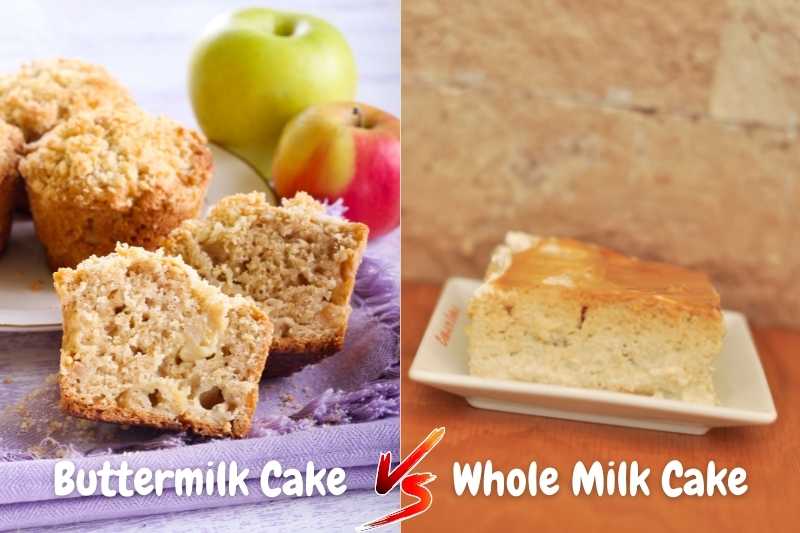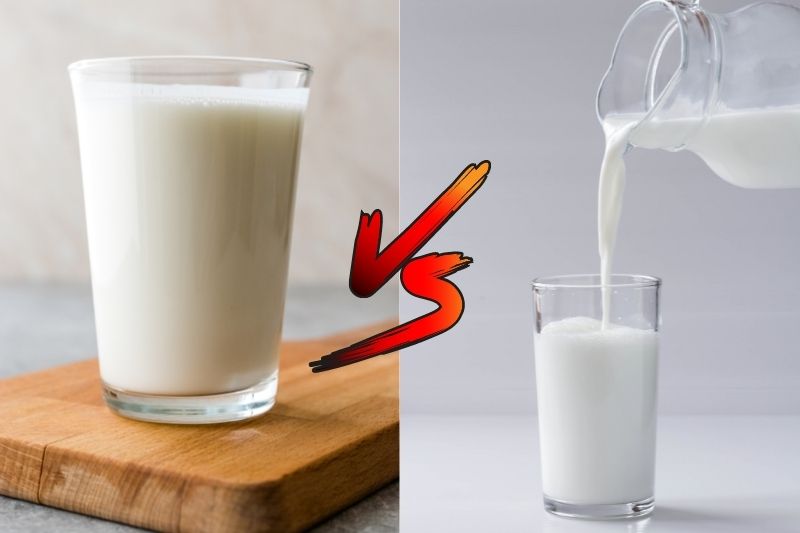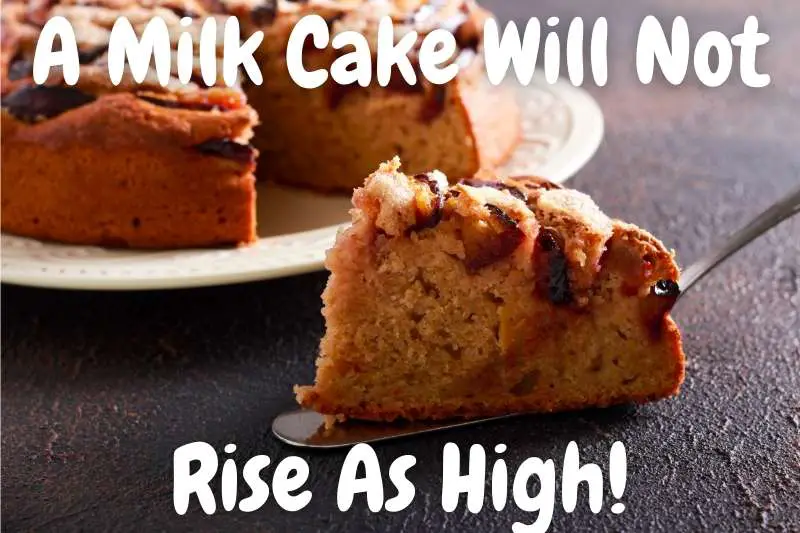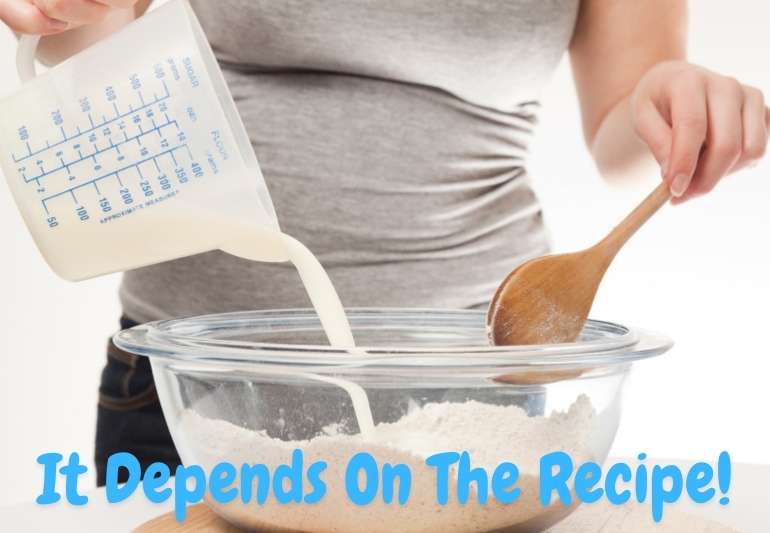This post contains affiliate links.
Have you ever started to make a favorite cake recipe calling for buttermilk and realized that you did not have any buttermilk? If so, it is natural to wonder if you can substitute milk. You may even wonder what is the difference between using whole milk and buttermilk in a cake.
As a general rule, there is a big difference between buttermilk and whole milk when baking. Buttermilk contains more acid than whole milk which reacts in the batter. Also, you are changing the ratio of dry ingredients to wet ones because buttermilk is thicker which affects the texture of the batter.

Understanding the differences between buttermilk and whole milk and which one you should use to create the best cakes is key to being a successful baker. Keep reading as we delve into this subject in more detail!
Should I Use Buttermilk or Milk in My Cake?
Generally speaking, you must use the ingredient that the recipe calls for when baking a cake. Not using the correct one will affect the cake’s texture and color. People with sensitive taste buds can also tell the difference in the way the cake tastes when comparing buttermilk and whole milk batters.
If you used the same recipe to bake a cake with buttermilk and another one with milk and sat the slices on a plate in front of you, the chances are that you would notice critical differences.
The first difference would be the texture.
The cake made with buttermilk would be fluffier than the one made with milk. You would also discover that it is more tender than the cake made with milk.

*By the way, I always wanted to be able to store my cakes the right way but I never found a good container that could fit my large cakes. However, I recently came across an Extra Large Cake Carrier/Storage Container That Holds up to 12 inch 3-layer Cakes. This carrier was perfect for storing my large cakes. You can check out this Cake Storage Container on Amazon here!
Using the two different kinds of milk would also have a color difference. The one made with milk would be slightly darker than the one made with buttermilk. This is because buttermilk has a higher acid level than milk.
Take a bite of each one, and you will discover that the one made with buttermilk has a more complex taste. Yet, it is not tangy. Meanwhile, the cake made with milk tastes sweeter.
Overall, when I’m doing my baking, I tend to follow the recipe exactly when it comes to buttermilk and milk. When working with your own recipes, it’s always great to experiment!
Can Buttermilk Be Substituted for Milk in a Cake Recipe?
As a whole, buttermilk and whole milk cannot be used interchangeably. Buttermilk has a higher acid content. As a result, Using the wrong one changes the way that the ingredient reacts with other ingredients in your cake. Using the recipe’s ingredients is key to baking a successful cake.
Buttermilk is naturally more acidic than whole milk. The pH level in whole milk ranges from 6.7 to 6.9 while the pH level in buttermilk ranges from 4.4 to 4.8.
The way that the lactic acid interacts with your baking powder, baking soda, and other ingredients affects the cake’s fluffiness and consistency.
Here I found a video breaking down whether to use buttermilk or milk in a cake:
*Side Note: You might also want to know why your cakes can sometimes come out Crumbly or Moist. I dug into the root of the problem and I wrote an article about Preventing and Fixing Crumbly and Moist Cakes, which you can check out here!
Secondly, if you pour whole milk and buttermilk into a glass, you will notice that the buttermilk is much thicker. Substituting whole milk for buttermilk will cause your cake to curdle because the water droplets cannot disperse through your creamed butter and sugar correctly.
Therefore, your cake would become lumpy.
Furthermore, you change the nutritional level of the cake. Most buttermilk has about 2.2 grams of fat and 99 calories per cup while milk has about 9 grams of fat and 157 calories.
What Happens if You Use Milk Instead of Buttermilk?
As a general rule, using milk instead of buttermilk changes the cake’s taste, color, and texture. Most of these changes occur because of the difference in acid levels between milk and buttermilk. Some differences occur because of the difference in fat levels.
Buttermilk does several things to a cake that whole milk does not do as effectively. First, buttermilk acts as a tenderizer in the cake. Therefore, your cakes will turn out more moist.
This occurs because the acid in the buttermilk disrupts the hydrogen ions in your cake’s proteins, causing them to unravel. The ions unravel too much if you use milk instead of buttermilk, and your cake will not be as tender.

*By the way, I recently wrote an article about The Similarities & Differences between Buttermilk and Heavy Cream. This article breaks down the real differences between these two while figuring out if you can use one over the other in a recipe. You can check out this article here!
Secondly, buttermilk gives the cake a tangier flavor. If you have ever eaten a bite of cake and thought that cake was too sweet, then chances are the baker did not use buttermilk.
While cakes made with buttermilk are still sweet, they have many more levels of flavor.
Third, the acid in the buttermilk helps the cake to rise. When the alkaline ingredients in your cake, such as baking powder, react with the acid in buttermilk, a neutralizing effect occurs, so your cake will rise.
If you use milk instead of buttermilk, then the starches in your cake break down and gel at a lower temperature.
This can cause your cake to flop rather than rise as it should!
Substituting milk for buttermilk makes it more challenging to get your cake to brown correctly. The acid in the milk stops the starch reaction from occurring properly. Therefore, cakes made with milk have a slightly darker color.
Does Buttermilk Make a Cake Moist?
As a whole, buttermilk makes a cake more moist than using milk. The way that the acid in buttermilk interacts with the gluten and other ingredients in your cake is the reason why cakes made with buttermilk are more moist.
One role of buttermilk in a recipe is that it breaks down long gluten strings. If these strings are not broken apart, your cake ends up tougher.
The acid in buttermilk also helps to break down protein. Like gluten, if the protein strands do not break adequately, your cake will not turn out fluffy.
*By the way, I recently wrote an article about How To Soften A Cake That is Hard. This article talks about all the ways to soften a hard cake without it losing its texture. You can check out this article here!
Is Buttermilk Better Than Milk for Baking?
Generally speaking, it is not always better to use buttermilk in place of milk when baking. You should use the dairy product that the recipe calls for as it will affect the texture, color, and taste of your baked good. Each has unique amounts of fat and acid in them which affects your baking.
In some baked goods where you desire a courser texture, milk is the best choice. Additionally, if you have baked goods that you want extra sweet, then use milk.
Always use whole milk because skim or reduced-fat will make baked goods too tough.
Buttermilk is the perfect choice for many baked goods. It causes chemical reactions needed in your baking to occur at a different rate.

Therefore, gluten and protein are broken down better, causing your baked goods to have a better structure. Additionally, buttermilk adds a tang to baked goods, which can help them from being too sweet.
You will love the color of baked goods containing buttermilk.
While I like to do my mixing by hand, I much rather prefer using a Stand Mixer instead. I recently wrote an article that talks about the 3 Best Stand Mixers that bakers can buy in each stage of their baking journey. After reviewing a few stand mixers, the Best Overall Mixer was the KitchenAid Artisan Tilt-Head Stand Mixer. You can check out this stand mixer on Amazon!
How Do You Make Your Own Buttermilk?
As a general rule, there are many ways to make buttermilk. One of the simplest is to put 1 tbsp. lemon juice or vinegar in 1 cup measuring cup before filling with whole milk. Stir to combine and let sit for 5 minutes. The key is to introduce an acid into your dairy product to thicken.
You can make buttermilk in many ways, including:
- Add 1 tbsp. red wine vinegar to 1 cup milk and allow to sit at room temperature until thick.
- Stir to combine 3/4 cup plain homemade yogurt and ¼ cup milk.
- Combine 1/3 cup powdered milk, 1 cup water and 1 tbsp. white vinegar. Let sit for 10 minutes before using.
- Add 1 tbsp. fresh lemon juice to 1 cup milk and stir to combine.
- Add 1 tbsp. apple cider vinegar to 1 cup milk and allow to sit until thick at room temperature.
- Stir to combine 1/2 cup plain homemade Greek yogurt and ½ cup whole milk.
- Combine 3 tbsp. whole milk with 1 cup of sour cream.
- Stir to combine 3 tbsp. Greek yogurt with 1 cup buttermilk.
- Add 1 3/4 tsp cream of tartar t to 1 cup milk and let it sit at room temperature until thick.
- Stir to combine 1/2 cup sour cream and 1/2 cup whole milk.
Make sure you are adding the ingredients into cold milk rather than hot.
Adding your acid into hot milk will cause it to curdle. However, adding it to cold milk will curdle much slower which causes your milk to thicken into a similar consistency as buttermilk.
Final Thoughts
Baking homemade cakes are a beautiful way to show your family and friends how much you love them.
I tend to use the type of milk called for in the recipe to get the best results. If you do not have buttermilk on hand, make your own with a buttermilk substitute!
